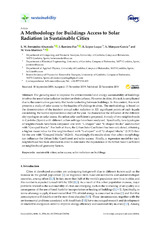A Methodology for Buildings Access to Solar Radiation in Sustainable Cities
Autor
Fernández-Ahumada, Luis Manuel
Ramírez Faz, José
López Luque, Rafael
Márquez García, Álvaro
Varo-Martínez, Marta
Editor
MDPIFecha
2019Materia
Sustainable citiesSolar access
Solar radiation on buildings
METS:
Mostrar el registro METSPREMIS:
Mostrar el registro PREMISMetadatos
Mostrar el registro completo del ítemResumen
The growing need to improve the environmental and energy sustainability of buildings involves the use of solar radiation incident on their surfaces. However, in cities, this task is complicated due to the constructive geometry that leads to shading between buildings. In this context, this work presents a study of solar access to the façades of buildings in cities. The methodology is based on the determination of the incident annual solar radiation in 121 significant points of each façade considering the twelve representative days of the year. To characterize the influence of the different city typologies on solar access, the urban solar coefficient is proposed. A study of two neighborhoods in Cordoba (Spain) with different urban settings have been analyzed. Specifically, two typologies of neighborhoods have been compared: one with “L-shaped” and “U-shaped blocks” and another with “Grouped blocks”. For both of them, the Urban Solar Coefficient has been calculated, obtaining a higher mean value for the neighborhood with “L-shaped” and “U-shaped blocks” (0.317) than for the one with “Grouped blocks” (0.260). Accordingly, the results show that urban morphology can influence the Urban Solar Coefficient and solar access. Finally, a regression model for each neighborhood has been obtained in order to determine the dependence of the Urban Solar Coefficient on neighborhood geometry factors.

